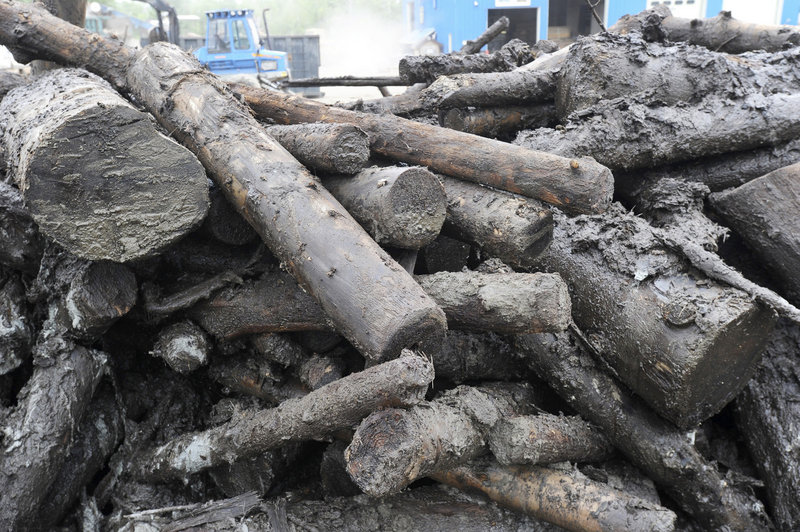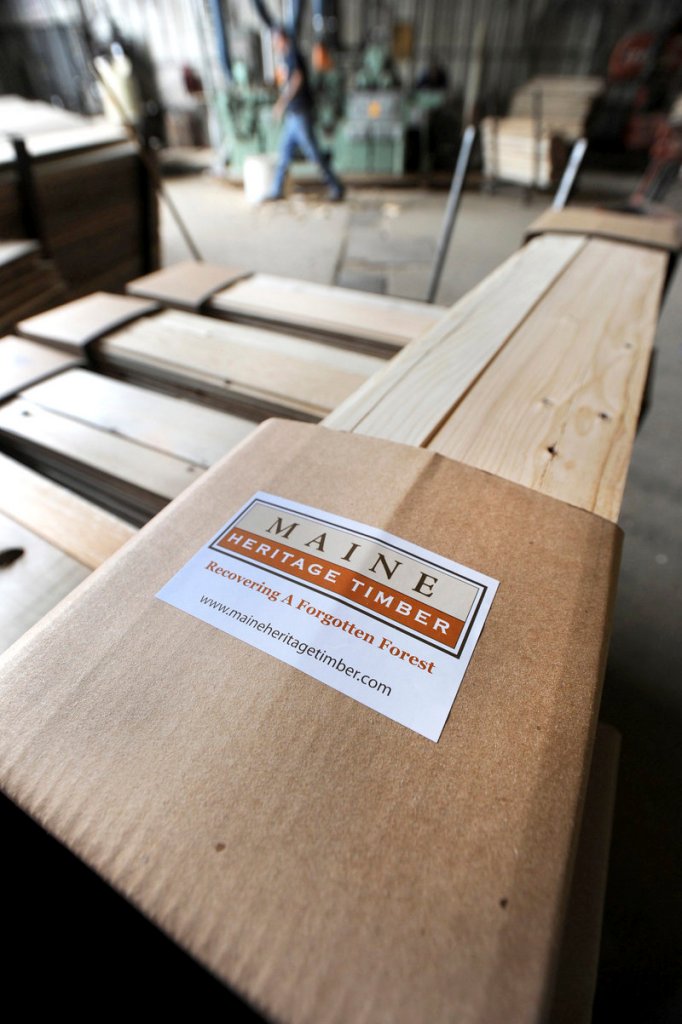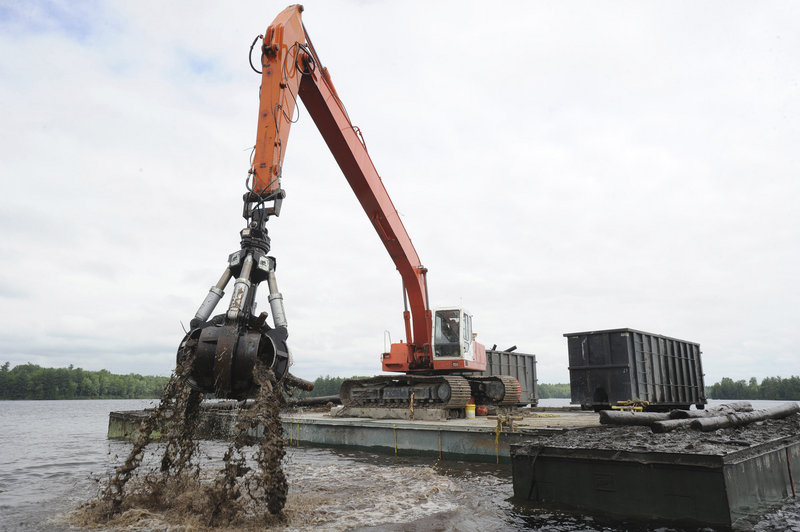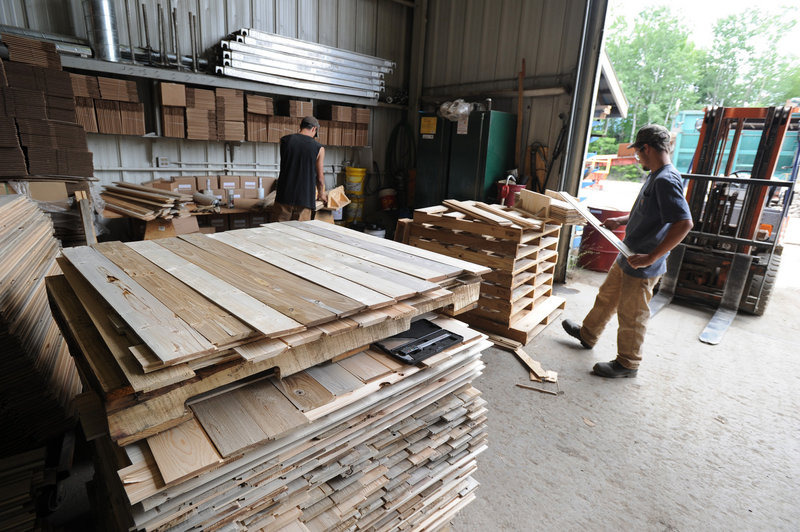MILLINOCKET – Quakish Lake is far from the trading floors of the New York Stock Exchange. And Tom Shafer, co-founder of Maine Heritage Timber Co., couldn’t be happier with his new job site.
“Where I come from, there were just bulls, bears and pigs,” said Shafer, 48. “Now, I’ve got bald eagles soaring overhead.”
Instead of shouting trades and watching the ticker tape on Wall Street, Shafer now reclaims forgotten logs from the bottom of a 1,000-acre lake in Millinocket. The wood hails back to Maine’s great logging era, when up to 1 million cords of wood sank to the bottom of the lake during drives to Great Northern Paper’s mill.
The cold water and protection from sunlight, oxygen and pests have preserved the wood and created great color variations and patinas. Shafer and his team are reclaiming the logs to turn the wood into flooring, wainscoting and furniture.
Shafer and his business partner, Steve Sanders, are at a critical point in the company’s growth. They aim to reach cash-flow break-even this month and start making money. Up to now, they’ve sunk $3.5 million in investments to buy equipment to haul the waterlogged wood out of the lake, shake off the bark, sort and cut it. Some of the wood is milled for wainscoting by Maine Heritage Timber and kiln-dried offsite, while the flooring is milled in West Virginia.
Maine Heritage Timber aims to generate $1.2 million in annual revenues this year, about double last year’s results. It’s an ambitious amount of growth, but Shafer expects the company’s new wainscoting product to be a strong driver of results.
“We respect the heritage of this project, for this town, for the people who toiled in the woods for years and years,” Shafer said. “We owe it to the people who cut this wood to make something special out of their hard work.”
Shafer’s move to Millinocket came after he left Wall Street in January 2008 with a buyout package from his employer, Van der Moolen. He took some time off, going fishing in Alaska.
Then the financial markets imploded in the fall of 2008. Getting another job on Wall Street wasn’t an option.
Shafer got a chance to work as the general contractor on a renovation project in Maine on a commission by his uncle. He lived in a Millinocket hotel for nine months and ate in the same restaurant every day — Scootic. Now he rents a house in Millinocket.
“I used to be the guy who calls the guy to fix stuff. Now, I have to figure it out,” Shafer said. “I’m a single guy in Millinocket. I eat, sleep and work. It’s a great place to start a business because there’s no distractions. What attracted me to the project is the romance. Driving down the street, I know everyone. Everyone wants that in life — to be connected.”
Although he may be “from away,” he’s not unfamiliar with Maine. His family has had a camp in the Millinocket area since the early 1800s, Shafer said.
He said he’s made an eclectic mix of friends in town, but part of him is still connected to New York. He reads The Wall Street Journal, The New York Times and the New York Post every day, in addition to Maine newspapers.
“Business is business. You may pay attention to different things in business — lumber prices are going through the roof right now — but it’s all business,” Shafer said.
Shafer and Sanders hatched the idea for their company in 2010. But the original concept — retrieving logs from the riverbed and delivering them to the East Millinocket pulp mill — collapsed when the mill shut down in 2011. That forced the team to come up with a new vision for the wood they retrieve, from May through Thanksgiving, from the cold waters.
The company tried to make money selling the wood for pulp for biomass to run boilers. That sells for $30 a ton. However, wood with rich patinas and interesting history can sell as wainscoting for $89 per 40-pound bundle. The flooring retails from $9.50 to $14 per square foot.
“The wainscoting, we feel, will really help our bottom line. Not everyone can afford $10-a-square-foot flooring. But wainscoting adds a special look without a major investment,” Shafer said.
Shafer estimates it could take 10 to 15 years to get through all the wood, which is a mix of spruce, fir, Eastern White Pine, birch, oak and maple.
“I want to be in every building supply store in the state of Maine,” Shafer said.
Shafer sees his target customer as a hedge fund manager who wants something no one else has — a unique conversation piece in the home that can be bragged about. Or the consumer who wants to make an environmental difference by buying reclaimed wood. Or a socially responsible business that wants to use recycled and reused materials.
“Our customers know they will pay a premium for it, but they love the beauty and love the story,” Shafer said.”We want the customer who will say, ‘Do you know where this floor came from?’ “
The woods in Quakish Lake were mostly softwoods that were cut and put into the water and floated down the river, where they were directed into the mill through underwater tunnels, said Robert Rice, a professor of wood science at the University of Maine.
The company, which employs 11 workers, plus Shafer and Sanders, has supplied materials for River Drivers pub in Millinocket, Sugarloaf’s 45 North restaurant and a restaurant in Amelia Island, Fla.
The flooring is a so-called engineered product, also known as a laminate. There’s a ¼-inch “wear layer” that’s applied to an 11-ply Baltic birch. It wears almost the same as an all-wood product, and it’s subject to less temperature and moisture expansion and shrinkage. Using only a “wear layer” or veneer of the reclaimed wood will allow the wood supply to last longer, Shafer said.
“It’s great that they’re recycling a natural resource that’s been preserved unknown under water. It’s a unique product. People who want unique things with a story — nothing would fit the bill any better,” said Viking Lumber President Dave Flanagan.
Viking plans to feature Maine Heritage Timber’s products. The wainscoting has unique patinas that hopefully will attract customers who want a distinct look, Flanagan said. He said the flooring would work best in a living room or a dining room, not in a high-traffic hallway or kitchen.
“It’s too valuable to use in a place where you’re tracking muddy boots. It’s not an industrial product. It’s a decorative product with history,” he said.
Rice said Maine Heritage Timber’s assortment of wood has varying degrees of strength and density, depending on the species of tree. The cold water and lack of oxygen eliminate the organisms that would normally decay wet wood, leaving the sunken timber strong and untouched. In other parts of the world, wood has survived on the ocean floor for as long as 5,000 years, gaining a jet black patina, Rice said.
The Janka Rating — or hardness rating — on Maine Heritage Timber wood is about 10 percent less than fresh wood, Rice said, but it is still resistant to most dents and scuffs.
“This is wood that grew very slowly. A lot of growth rings per square inch make it more resistant to heel marks. But no wood floor is immune to stiletto heels,” Rice said. “The people buying this wood are looking for a certain rustic appearance and an interesting story — and there’s definitely an interesting story behind this wood.”
Maine Heritage Timber, which also supplied wood for oars to L.L. Bean to mark that company’s100th anniversary last year, isn’t the only company recovering lumber from Maine waters.
DeadHead Lumber, which began in 2007, retrieves hardwood from Moosehead Lake. Its products are used mostly for industrial purposes such as flooring or tabletops in restaurants and stores.
DeadHead’s owner, Todd Morrissette, said he doesn’t see any problem with two companies competing in Maine. “DeadHeads” is the nickname for the sunken logs that collected along the bottom of Maine’s lakes and rivers during the log drives.
“It is a niche market, but the potential is so huge,” Morrissette said. “I don’t see us bumping into each other. I don’t see us as competition. We both benefit each other.”
Educating customers is a challenge because most people don’t know Maine’s logging history, Shafer said.
To broaden the product’s reach, Maine Heritage Timber rebranded itself from its original name of West Branch Heritage Timber, which was a nod to the West Branch of the Penobscot River. That was a little too localized to gain national or regional recognition.
“Maine is a powerful brand. We need to leverage it,” Shafer said. “Everyone loves Maine.”
Jessica Hall can be contacted at 791-6316 or at:
jhall@pressherald.com
Send questions/comments to the editors.







Success. Please wait for the page to reload. If the page does not reload within 5 seconds, please refresh the page.
Enter your email and password to access comments.
Hi, to comment on stories you must . This profile is in addition to your subscription and website login.
Already have a commenting profile? .
Invalid username/password.
Please check your email to confirm and complete your registration.
Only subscribers are eligible to post comments. Please subscribe or login first for digital access. Here’s why.
Use the form below to reset your password. When you've submitted your account email, we will send an email with a reset code.